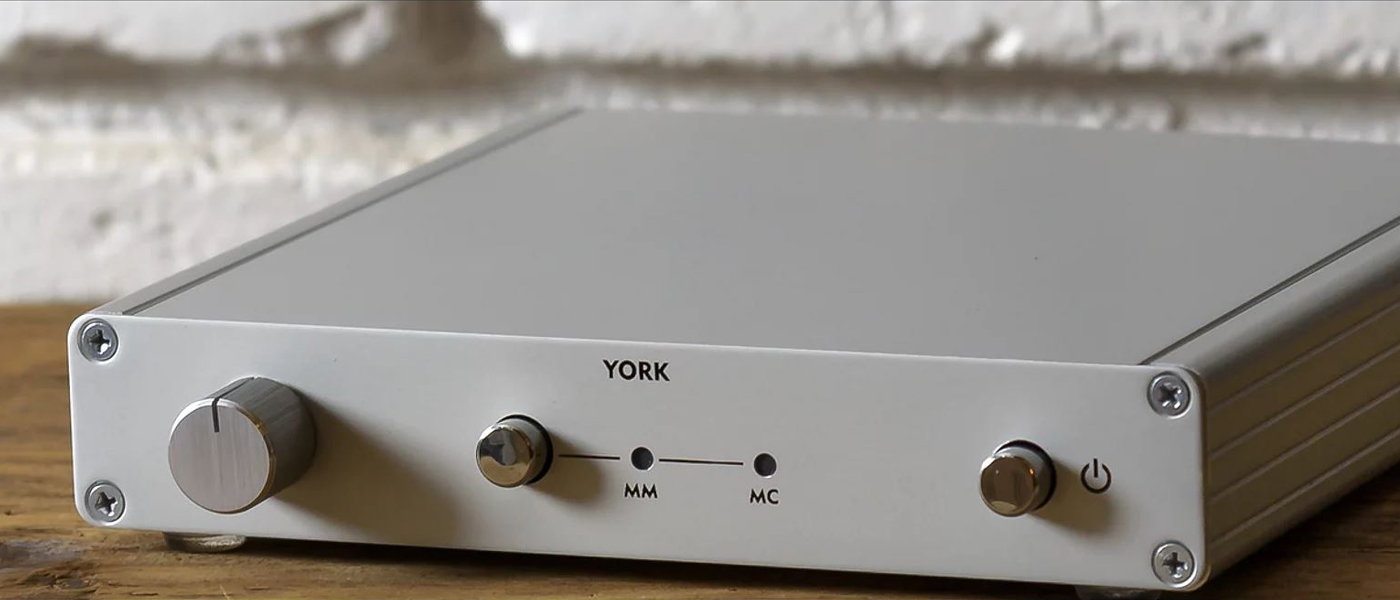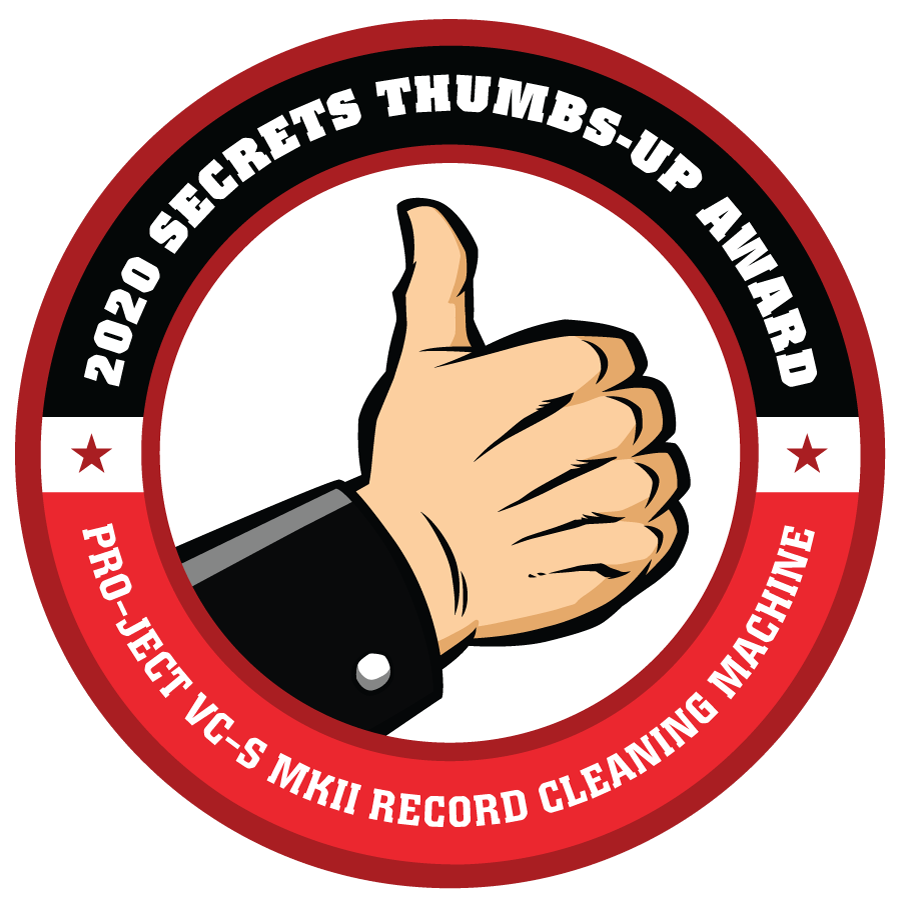
Skeptical that a one-step record cleaning fluid is all you really need? Both the Pro-Ject VC-S MKII Record Cleaning Machine and the Groovy Hi-Fi Solutions TM-8 record cleaning fluid invite you to revisit such assumptions.
High-performance, no-hassle record cleaning at an affordable price.
Pro-Ject VC-S MKII Record Cleaning Machine & Groovy Hi-Fi Solutions TM-8 Record Cleaning Fluid
- Simple to use, maintenance-free, vacuum record cleaner
- One-step, scientifically developed, high-performance record cleaning solution
- Notable improvements in the sound quality of records, both used and new
When I finally got around to purchasing my first turntable around 2012, I started a record collection slowly. Rather than shopping online or heading to a giant retail store like Amoeba, I decided to check out a local community college flea market that a DJ had recommended. After my first visit, I ended up with a handful of mass-produced 70s and 80s records, all of which were used and all of which needed a thorough washing. Hours of audio forum research later and with a good deal of uncertainty whether vinyl would hold my interest long-term, I decided it was too soon to make a substantial investment in record-cleaning equipment. I was, however, fortunate enough to have the opportunity to review the Spin-Clean Record Washer. Given its cost and ease of use, it was a logical introduction and I came away impressed. In fact, I ended up purchasing the Spin-Clean and owe it some degree of credit for pushing my interest in vinyl forward. A cleaner record should also make the job of your stylus easier, thus prolonging its useable life.
As much as I have been transfixed in moments when good music meets good recording meets good mastering meets good pressing meets well-matched audio system, static is a nagging analog issue and, unlike azimuth, anti-skate, loading, and the other “tweak-aholic” aspects of vinyl playback, it is neither fun nor interesting to chase. In other words, I don’t mind static-laden needle drops in television or movie scenes, but in real life, the dynamic range and intimacy which vinyl is capable of can be, almost by definition, obscured by such noise. The disappointment and frustration comes when you start to entertain the notion that static-free playback happens mostly by chance or, at the very least, seems due to a complex interaction of factors beyond your control.
As time went on, I began experimenting with different record cleaning techniques and, invariably, different fluids in order to minimize static. As most of the records I was purchasing were under $10, convenience and cost remained primary considerations, so I focused on hand cleaning and one-step fluids. Initially, that led me to Mobile Fidelity’s popular record cleaning brush and its highly-regarded (alcohol-based) “ONE” formula. The transition to full manual cleaning, while perhaps slightly more time-consuming, was a positive one. I now had much more control over the amount of force applied to clean a record, some of which were in fairly rough condition, including visible and hard-to-remove surface residue.
Secrets Sponsor
Hand cleaning is not without its negatives, however, and the main one for me was how to dry the records after the wet clean. On the one hand, if you have enough floor space, you could set them out to air dry somewhere, but space will limit the number of records you can get through at one time. I used to air dry records by racking them in my empty dishwasher, but that also involves waiting for them to air dry and limits the number of records you can get cleaned in a reasonable amount of time. My routine was to wait to clean records until I had 25 or so to get through and that meant not only were there often long waits to play records I had purchased, but the actual cleaning and drying were more time-consuming than I would have liked.
My attempts to dry records with what purported to be a lint-free cloth did not seem to help, but rather, make static worse. Accordingly, I became sold on the idea of a vacuum record cleaning machine if, for nothing else, to dry the record thoroughly and minimize static issues. I also thought motorized rotation would allow me to use less fluid while spreading it more evenly and, combined with the much faster vacuum-assisted drying, make cleaning records much more efficient.
Pro-Ject VC-S MKII
Vacuum record cleaning machine
Rotates at 30 RPM
Should completely dry a record in no more than 2 rotations
Accessories included:
goat hair fluid application brush, 100ml Pro-Ject “Wash-It” cleaning fluid concentrate (sufficient to clean approximately 135 records), fluid mixing bottle, replacement protective strips for vacuum arm, detachable used fluid drain spout, detachable power cord
Screw-down clamp protects record labels from fluid
Used fluid reservoir (2.5 liters) with visible fill level
Optional arm for 7” records is available
Optional hinged lid available
Dimensions:
16.75” W x 11” H (including arm) x 13” D
Weight:
23 lbs
MSRP:
$499
Company:
Company Directory:
Groovy Hi-Fi Solutions TM-8 Record Cleaning Fluid
One-step, alcohol-free record cleaning fluid
MSRP:
$25 (8oz); $44 (16oz); $70 (32oz); $195 (1gal)
Company:
Company Directory:
SECRETS Tags:
analog, turntable, vinyl, record, vinyl reviews 2020, vinyl accessories, reviews 2020, vinyl accessories review 2020
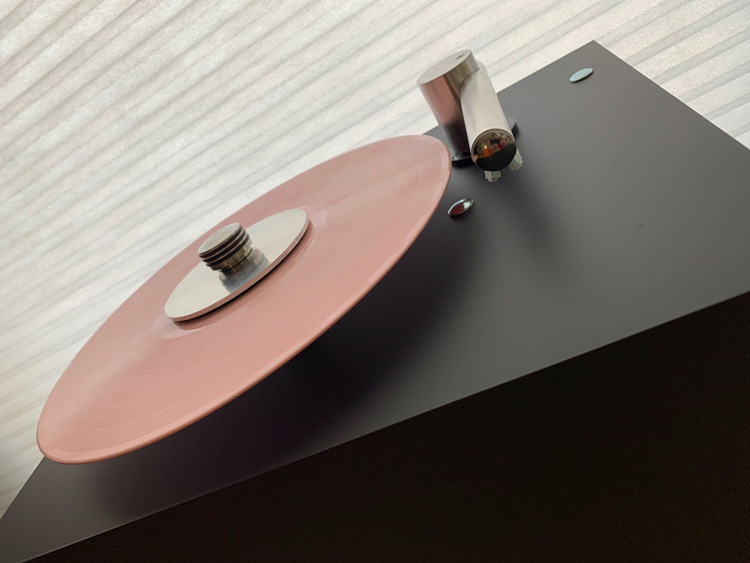
The VC-S MKII is a simple black box. It is nicely finished in a smooth black vinyl material tightly wrapped over the MDF surface. The MKII incorporated several performance and cosmetic improvements over the original VC-S, including a re-designed record clamp, a new spindle, silkscreened labels, a nylon flange between the vacuum arm and base (to eliminate binding), and replacing the wood handle of the record brush with a synthetic one. Recently, Pro-Ject has gone a step further and introduced the VC-S2 ALU ($649) which, most noticeably, features an aluminum acrylic sandwich construction, and dispenses with the vinyl-wrapped MDF of the VC-S MKII. Pro-Ject touts the new aluminum cabinet as “able to withstand excessive fluid spill without compromising the chassis” and also reduces noise from the motor. As I tend to err on the side of too little rather than too much fluid, the former is not a real selling point for me, especially since I would promptly wipe any such spill. At any rate, the ALU model is also lighter, ceding over five pounds to the VC-S MKII. That too, however, is a neutral “upgrade” to me. Notably, Pro-Ject has also introduced a compact version of the VC-S2 ALU, the VC-E, which retails for the same $499 as the VC-S MKII. The VC-E features a smaller waste tank but otherwise appears to possess a similar feature set.
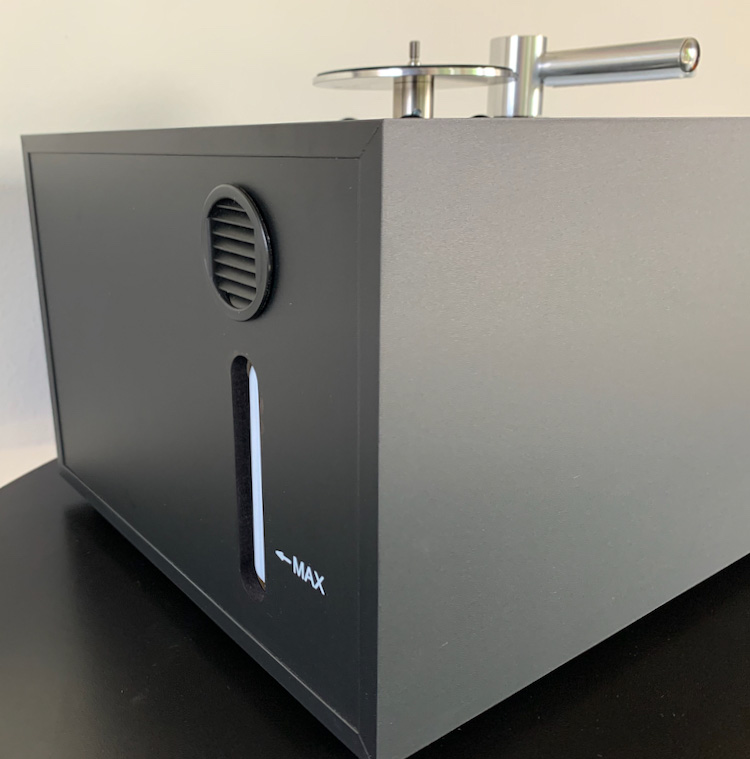
The VC-S MKII controls are few and, thankfully, clearly marked. There are two main rocker switches, one controls rotation direction while the other simply turns the vacuum on and off. There is also a small main power switch next to the AC power inlet. The motor will perform a full rotation in two seconds. The simple-to-use aluminum clamp covers the record label completely, ensuring that no cleaning fluid will penetrate. Thankfully, the screw-down action takes very little effort. The aluminum vacuum arm is substantial and well designed. It is lightweight to facilitate the easy manual movement between its two pre-stopped positions—clear of the record to place or remove the record and apply fluid and then over the record to vacuum away fluid. The used fluid capacity is 2.5-liters and the waste tank features a window indicating the remaining capacity. A detachable spout facilitates used fluid removal. Also available is an optional dust cover, but the utility of that escapes me. Generously, Pro-Ject does provide several accessories free of charge, including 100ml of their own “Wash It” cleaning fluid concentrate and a mixing bottle for the same, a goat hair fluid application brush, and an extra set of the velvet sweeper strips for the vacuum arm that lightly brush the surface of the record.
Secrets Sponsor
After going through most of an entire bottle of Mobile Fidelity’s One fluid, additional research and curiosity led me to the Audio Intelligent Premium One-Step Formula No. 6. This fluid was somewhat of a revelation—it managed to reduce the amount of audible static, generally making the records quieter and thus more dynamic and enjoyable. As I reached the end of my bottle of Audio Intelligent fluid, I was curious whether any other fluids were worth trying.
After coming across several references to a one-step cleaner called “TM-8,” I reached out to the manufacturer, Groovy Hi-Fi Solutions, which is conveniently located in the Los Angeles area, where I live. Groovy is affiliated with and resides alongside the well-regarded audio retailer, Brooks Berdan Ltd. The team at Brooks Berdan has long been known as experts in everything analog. After exchanging a few emails with Groovy’s co-owner, Sheila Berdan, I was invited in for a visit. I ended up spending the afternoon with Sheila, Joe Knight (Groovy’s other co-founder), and many of Brooks Berdan’s knowledgeable and friendly team. I came away with a deep appreciation of the dedication and effort that went into developing TM-8.
TM-8 has been around since 2014. It is a reformulated version of the highly-regarded Torumat TM-7, which was developed decades ago by a chemical engineer and rocket fuel designer named Toy Shigekawa. Groovy purchased the TM-7 formula and engaged two chemical engineers to secure production through currently available resources, including the highest quality commercially available ingredients. The result, says Groovy, is an ultra-pure, chemically-sound fluid that will not break down over time. Because one of the design goals was to clean the record without the use of substances that might harm or otherwise degrade vinyl, TM-8 contains no alcohol. Another goal, addressed by the use of ultra-pure ingredients, was to remove as much residue from the record as possible without requiring a separate rinse. Groovy maintains that TM-8 lowers surface noise and improves tracking, resulting in increased resolution and a neutral sonic signature. While Groovy does not recommend the use of TM-8 with ultrasonic record cleaning machines such as Audio Desk, TM-8 is perfectly suited to either hand cleaning with a vacuum-based machine such as the Pro-Ject.
The VC-S MKII could not be easier. All you need to do is unbox the unit, attach the base plate of the clamp via a single screw, and apply the self-adhesive protective foam to it. Set it on a steady surface, plug it into the wall, and you are ready to go. I was not using Pro-Ject’s included “Wash It” record cleaning fluid, so there was no need to fuss with mixing that.
The TM-8 bottle features a flip-top pour spout, but rather than applying the fluid directly from the bottle, I filled a small beaker so that I could apply it more precisely by using an eyedropper. Groovy Hi-Fi Solutions does not recommend diluting or mixing TM-8 with any other types of water or fluid as the performance of TM-8 will be greatly compromised if altered.
I was very surprised by two things.
First, the vacuum in the VC-S MKII is loud. To be fair, I attribute my surprise mostly to this being my first experience with a vacuum-based record cleaning machine. Curious, I downloaded some decibel meters onto my phone. While the results varied enough between several freebie apps to cause me to question their accuracy, one of them measured a power tool like peak of 89db with the vacuum active. Needless to say, this is loud enough to annoy others in adjacent rooms. I can therefore confirm—this record cleaner does indeed sound like a vacuum. I felt a lot better once I inserted earplugs.
Noise is, however, the price you must pay for the superb performance. The VC-S dried records thoroughly and quickly. A rotation or two in either direction and you can put the record back in its sleeve. No real fuss, and, more importantly, no muss. The clamp functions perfectly and not one label got wet.
The second thing that surprised me was how incredibly easy the TM-8 spread across the record surface. In other words, a little goes a very long way. This is partly due to the fact that it is easy to determine coverage because the TM-8 reflects light like a mirror. A lot of the albums in my collection have multiple discs and I have a few substantial box sets, so while I did not count the number of record sides I was able to clean, I did not use the entire bottle of TM-8 (yet). I estimate that a 16oz bottle of TM-8 should easily clean both sides of 250 records.
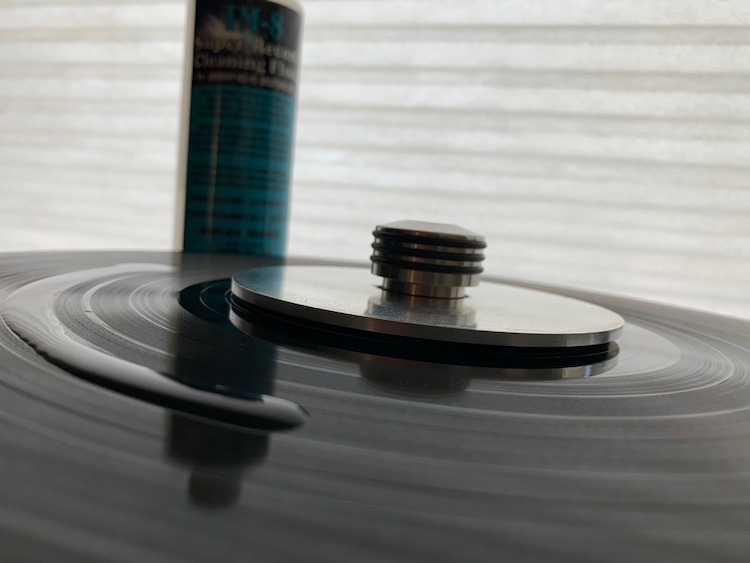
Another thing I noticed about TM-8 was that, whereas before, a clean record might pick up some random lint inside even a new record sleeve, a TM-8 treated record seemed to repel such material. This was evident when I went to play a newly-cleaned record. As is my habit, I run the anti-static brush across the surface of the record every time before playing it. Given how shiny the record surface becomes after cleaning with TM-8, it is very easy to see lint or dust on the record surface. To my surprise, records once cleaned, seemed to stay clean, even from residual lint or dust.
As for the sonics, the TM-8 and the VC-S MKII are an inspired pairing. I know there are more expensive record cleaning machines out there, but it is difficult to fathom in what ways they might better the results I was able to achieve. Put simply, it is not an exaggeration to say that records became eerily quiet. A particularly noisy copy of Roberta Flack’s First Take is a good example. Not only was the abundant static I recalled essentially eliminated, the stylus just seemed more settled in the groove. I’m speculating, of course, but I draw that conclusion from what I heard and what I heard consistently. Horn instruments had more immediacy on attack and the vocal track seemed more upfront and bigger than I remembered. The easiest way to describe it is a shift from background music to an experience that felt faster and just grabbed your attention. Even though at times the dynamics were jarring, my main takeaway was that the music became easier to follow and more engaging.
The sonic benefits of the VC-S MKII and the TM-8 were obvious and repeatable whether a record was new or used.
- Uncomplicated, efficient, well-built record cleaning machine with a powerful vacuum and free accessories
- TM-8 tames and rejects static and lint—the best record cleaning fluid I have used
- NONE
The Pro-Ject VC-S MKII is one of the more affordable vacuum record cleaning machines on the market and is made by one of the most well-known manufacturers out there. It is as close to maintenance-free as you are likely to find and therefore offers terrific value for money. The Groovy Hi-Fi Solutions TM-8 record cleaning fluid is priced at a premium compared to many popular solutions, but Groovy says the cost to manufacture TM-8 is indeed expensive both because of the ingredients and the labor. I believe the performance of TM-8 fully justifies any premium. I had a small amount of another fluid which I used it to clean a record on the VC-S. I then played the record. After that, I cleaned it with TM-8 and played it again. It sounded quieter. Furthermore, you will likely be surprised at how little TM-8 you need to effectively clean a record and Groovy does provide free shipping on all orders.


